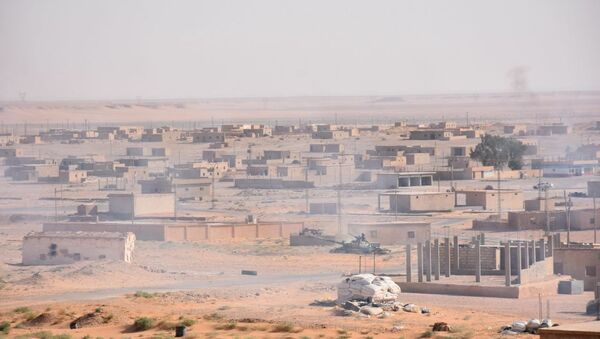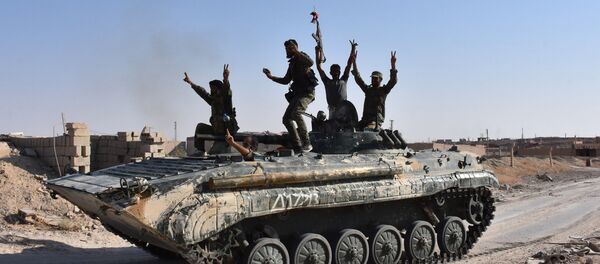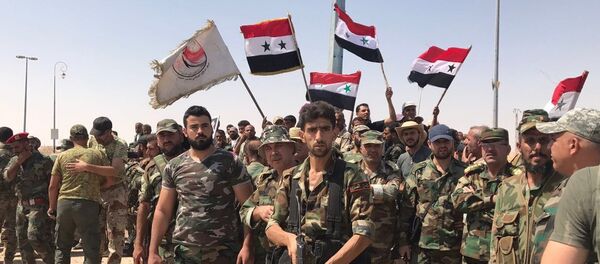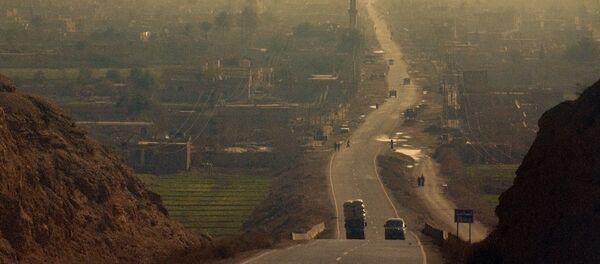DEIR EZ-ZOR (Syria) (Sputnik) — Deir ez-Zor defense units and the recently arrived Syrian army reinforcements have launched an offensive against Daesh controlled territories of the city, which lies on the Euphrates River.
A RIA Novosti correspondent witnessed the launch of the offensive near the airport in the northern part of the city and learned about an important operation not far from an air base in eastern Deir ez-Zor.
Difficult Task
The offensive began at 06:00 a.m. local time (03:00 GMT), as stipulated by the operation’s headquarters the other day. Units of the country's army, military reconnaissance and the 17th Division started fulfilling their task.
Less than seven days ago, the cemetery was considered the most dangerous part in Deir ez-Zor. Terrorists and the city’s defenders took turns attacking each other as they tried to gauge their respective strengths. The siege which which had been laid upon the city for three years was lifted on September 5, with the balance of power tipping in the Syrian army's favor. Truck convoys delivered ammunition, which remains in short supply, with reinforcements punching holes through the Daesh positions and entering the city from the south and the west. But the city’s liberation remains a difficult task.
Terrorists had besieged the local airport for nine months, and it took Syrian military commanders less than two days to prepare for the operation and ultimately lift the siege.
Government forces were deployed near the city cemetery and moved toward the airport to help their comrades there.
The cemetery covers several square kilometers on the city’s outskirts. In the past three years, soldiers built lines of defense here and dug trenches while trying not to damage the graves.
Planes Must Fly
We decided not to press our luck while looking for a road leading toward the frontline. Sometime later, we were quite lucky to meet with General Bader Khadlya, who commands the air base’s garrison at the airfield.
"I am very happy that you were not afraid and came here. What can I tell you about the base’s current status? We are ready to use the undamaged runway. And we remain on our guard, and we are combat-ready," the general noted proudly.
The garrison’s commander was truly happy and smiled all the time as he talked about his soldiers, who repelled daily Daesh attacks. He also talked about how they lived, and how all of them refused to fall back even an inch, regardless of the situation.
He indicated that lifting the Daesh siege was only part of the job. According to the general, it is important to establish a security perimeter around the airfield for handling transport aircraft and warplanes.
After guaranteeing safe takeoffs and landings, the city will be able to quickly receive tens of tonnes of food and other necessities every few hours daily. This would be a major achievement because it takes a truck convoy at least ten hours to reach Deir ez-Zor.
The city’s 80,000-plus residents started receiving food from the state on the third day after the siege was lifted. However, several hundred tonnes is not enough to effectively supply so many people, and the local situation remains on the verge of a humanitarian disaster.
Daesh Supply Line
The decision to start lifting the siege in the above-mentioned sector was not a coincidence. After an artillery barrage, the Syrian soldiers advanced in the Huweija district, which accommodates the only supply line for the Daesh militants entrenched in several city blocks.
"You can peer through the slit and see enemy positions 50-100 meters (164-328 feet) from here. But you cannot see anyone there because they are all hiding inside hardened bunkers. The terrorists have built effective lines of defense over the past three years, and they have planted mines along access routes. They used to attack in the past, but now it is our turn," a colonel of the Republican Guard noted.
Indeed, the terrorists are offering a tough resistance. They continue to shoot at us non-stop, while hiding from air strikes. It should be noted for justice’s sake that Republican Guard soldiers have built a very reliable line of defense here, and have dug tunnels and full-depth trenches along the city’s outskirts and in residential areas.
An improvised operations headquarters is located inside an unfinished building 600 meters from the frontline.
Two generals and their aides issued orders to their soldiers, while peering through binoculars. General Issam Zahreddine grew sick and tired of sitting all the time with a radio transceiver in hand, regularly entering trenches leading to the forward edge of the battle area (FEBA) to assess the on-site situation and to help his officers whenever necessary.
"Did you see that mortar round explode near the water reservoir? That’s where I was wounded in 2014," the General said after opening the back door of the building and pointing at the cloud of dust.
Several minutes later, the commander obviously decided to switch up the battle tactics. He summoned his officers and assigned new tasks while using a stick to draw a map of the local terrain on the ground.
Intense fighting raged for many hours, with machine gun rounds flying over our temporary headquarters from various directions.
"The terrorists who realize the importance of this position have concentrated substantial forces here," an officer who spent the entire nine-month siege in the city told us.
Since early 2017, Daesh militants attacked defensive positions in Deir ez-Zor’s Huweija district almost every day. One such attack involved 14 car bombs driven by suicidal terrorists. Three car bombs also tried to hit the area today but were destroyed in time.
The Syrian army continues to expel terrorists from the city, but no one can say how long this operation will last. One thing is certain: it is high time to eliminate terrorists in Deir ez-Zor and the whole of Syria. The sooner this happens, the better.





